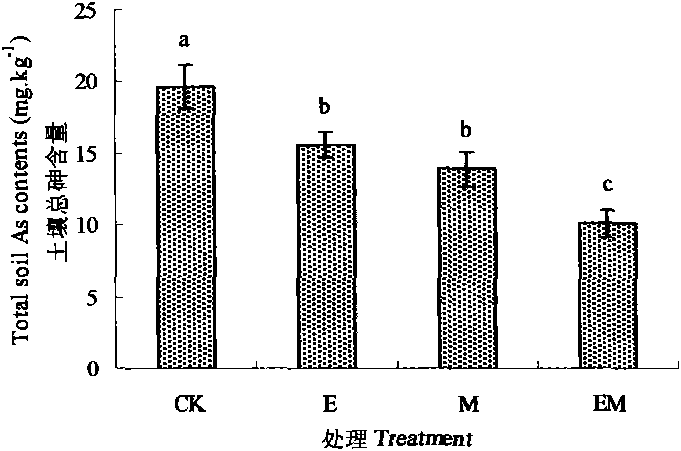Method for improving phytoremediation efficiency of low-concentration arsenic-contaminated soil
A phytoremediation and soil remediation technology, applied in the field of ecological restoration of pollution and phytoremediation of low-concentration arsenic-contaminated farmland soil
- Summary
- Abstract
- Description
- Claims
- Application Information
AI Technical Summary
Problems solved by technology
Method used
Image
Examples
Embodiment 1
[0018] Propagation of AM mycorrhizal fungi: the tested AM mycorrhizal fungus is a high-efficiency composite bacterial agent composed of Glomus spp. and Acaulosporaspp that promotes the absorption of arsenic by plants. Sudan grass (Sorghum sudanese (Piper) Stapf.) is used in summer and clover is used for propagation in winter, and the substrate is river sand; The rhizosphere soil that infects propagules such as root segments is the compound bacterial agent inoculum.
Embodiment 2
[0020] Soil for test: collected in Lili Town, Wujiang City, Jiangsu Province, the physical and chemical properties of the soil are: organic matter 20.90g.kg -1 , all N 1.27g.kg -1 , all P 0.31g.kg -1 , effective K 87.13mg.kg -1 , pH 6.2 (1:2.5 water extraction).
[0021] Mix the above soil evenly, and breed mycorrhizal seedlings and non-mycorrhizal seedlings of corn indoors. Corn mycorrhizal seedlings: Add AM mycorrhizal fungus compound bacterial agent to the soil below the corn seeds by layer application; non-mycorrhizal seedlings are layered with inactivated bacterial agent 50g, and transplanted after 2 weeks of seedling cultivation.
Embodiment 3
[0023] General situation of the test area: The test area is located in Lili Town, Wujiang City, Jiangsu Province, the key pollution element: As: 31.2 mg / kg, and the physical and chemical properties of the soil are the same as in Example 2.
[0024] Experimental scheme: 4 treatments were designed in this study: no inoculation control (CK), inoculation of earthworms (E), inoculation of AM fungi (M), inoculation of AM fungi and earthworms (EM), 3 replicates for each treatment, 10m for each plot 2 , arranged randomly. The corn seedlings were transplanted in April, and the corn spacing was 40cm×40cm. When transplanting, the control treatment and the earthworm treatment were transplanted with non-mycorrhizal seedlings, and the other treatments were transplanted with mycorrhizal seedlings. For the treatment of inoculation of AM bacterial agent, 50 g of bacterial agent was added to the seedling holes before transplanting; for the treatment of inoculation of earthworms, some crushed s...
PUM
 Login to View More
Login to View More Abstract
Description
Claims
Application Information
 Login to View More
Login to View More - R&D
- Intellectual Property
- Life Sciences
- Materials
- Tech Scout
- Unparalleled Data Quality
- Higher Quality Content
- 60% Fewer Hallucinations
Browse by: Latest US Patents, China's latest patents, Technical Efficacy Thesaurus, Application Domain, Technology Topic, Popular Technical Reports.
© 2025 PatSnap. All rights reserved.Legal|Privacy policy|Modern Slavery Act Transparency Statement|Sitemap|About US| Contact US: help@patsnap.com


